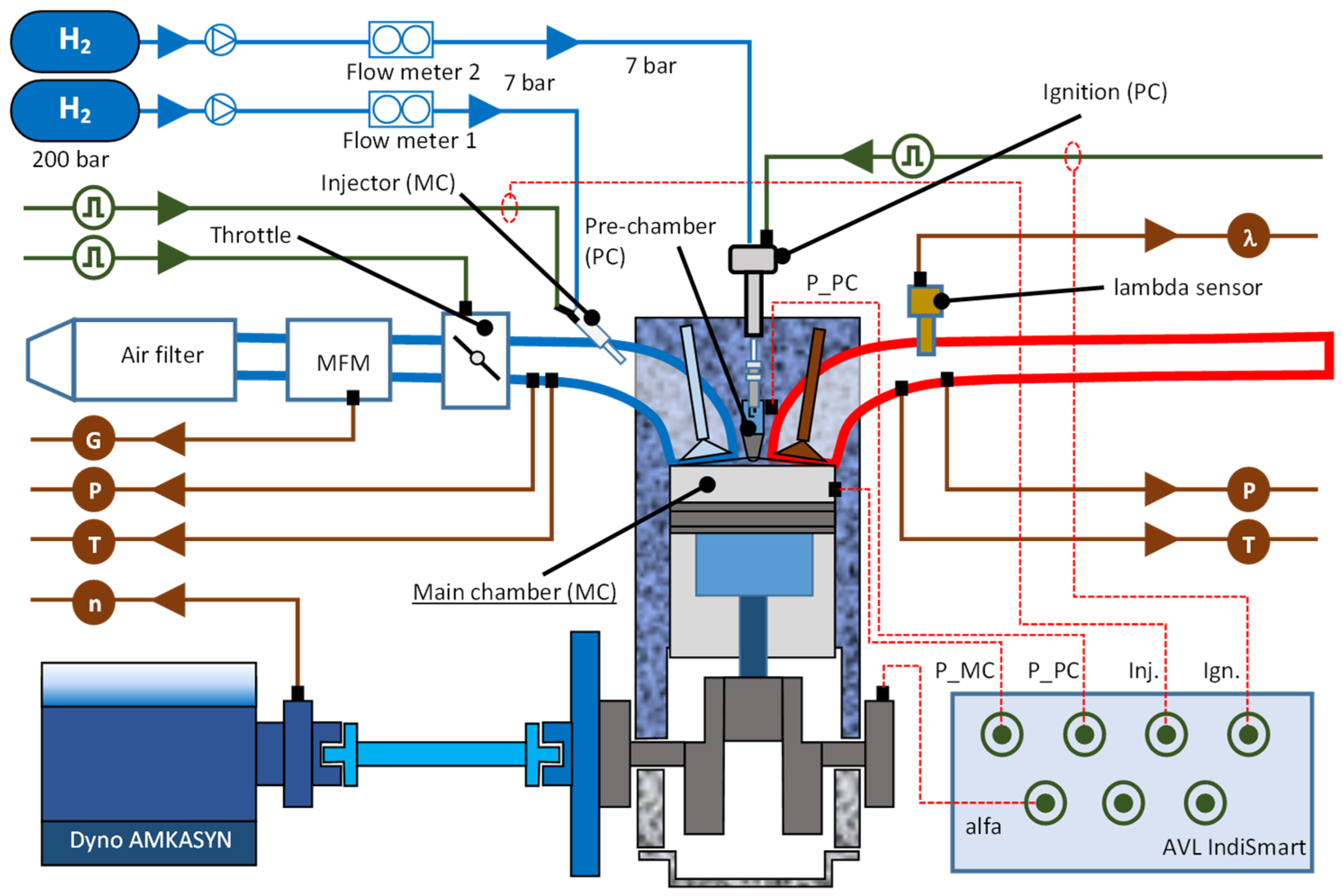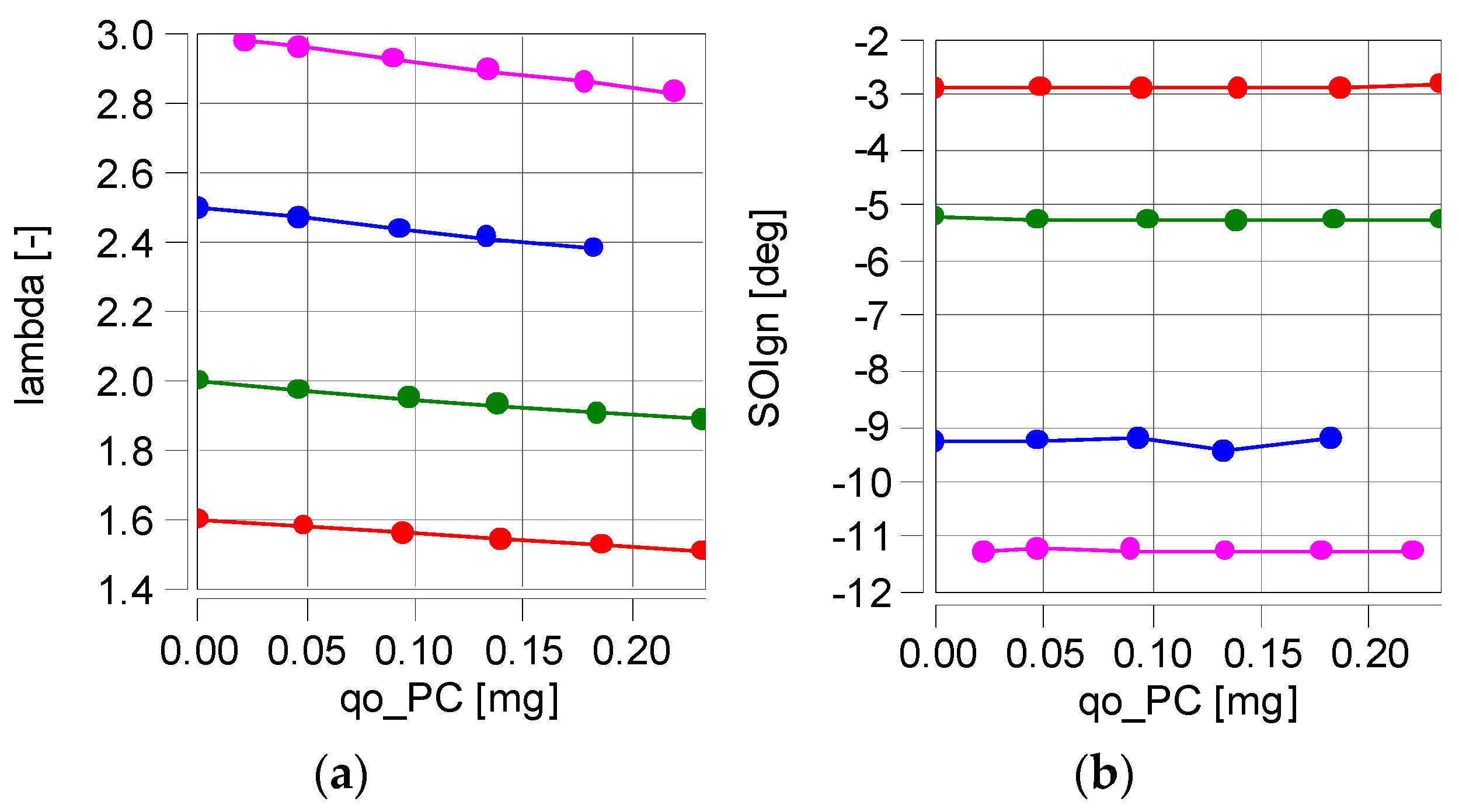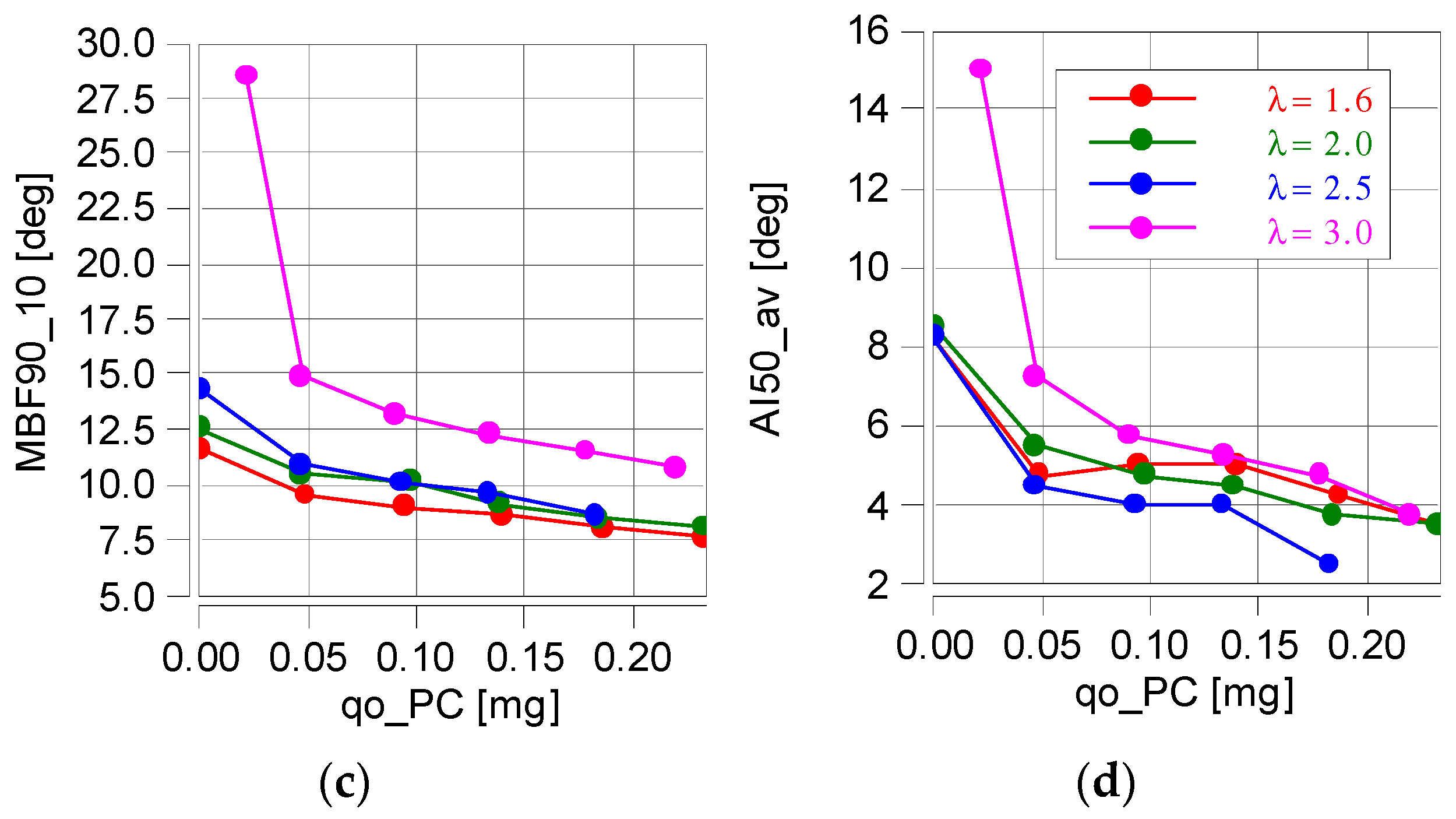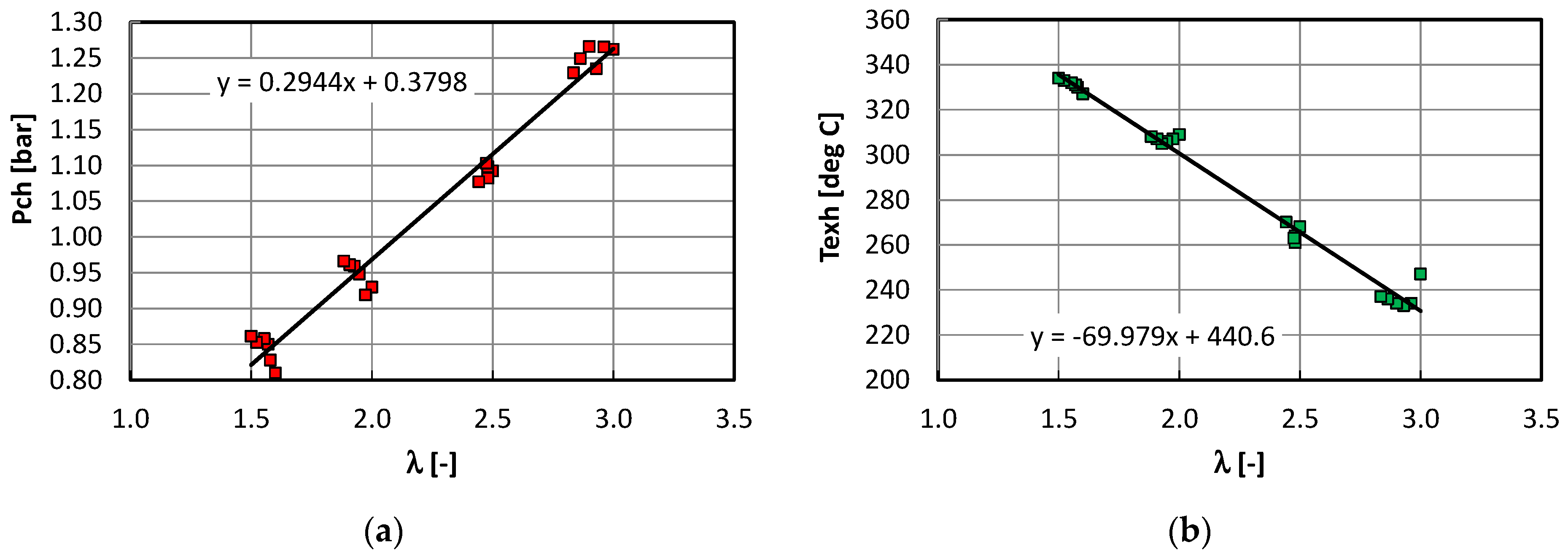A New Method of Failure Mode and Severity Effects Analysis for Hydrogen-Fueled Combustion Systems
Abstract
:1. Introduction
2. Materials and Methods
2.1. Description of the Test Stand
2.2. Description of Analysis Methodology and FMESA Analysis Method
- Exhaust temperature (Tex)//MPi1;
- Shift in the center of combustion (CoC)//MPi2;
- Exhaust outlet pressure (Psp)//MPi3;
- Boost pressure (Pin)//MPi4;
- Excess air ratio (λ)//MPi5;
- Amount of nitrogen oxides in the exhaust gasses (NOx)//MPi6.
2.3. Analysis of the Internal Combustion Engine Operating Conditions
3. Results
3.1. Tabulated Severity Scale of Failure to Two-Stage Hydrogen-Fueled Combustion System
3.2. FMESA: Selected Results of Failure Analysis by the FMESA Method
4. Discussion
5. Final Remarks
Author Contributions
Funding
Data Availability Statement
Conflicts of Interest
Abbreviations
| BDC | bottom dead center |
| CoC | center of combustion |
| E-FMECA | empirical FMECA |
| ETA | event tree analysis |
| FE | final effects |
| FM | failure mode |
| FMEA/FMECA | failure mode and effect analysis/failure mode, effects and criticality analysis |
| FMESA | failure mode and effects severity analysis |
| FS | failure severity |
| FTA | fault tree analysis |
| HAZOP | hazard and operability study |
| HPL | high parameter limit |
| LE | local effect |
| LHV | lower heat value |
| LPL | low parameter limit |
| MC | main chamber |
| MPs | measurable parameters |
| NHTSA | national highway traffic safety administration |
| P | pressure |
| PC | pre-chamber |
| PFI | port fuel injection |
| PF-FMEA | product function failure modes and effects analysis |
| PI-FMEA | product inter-face failure modes and effects analysis |
| PRD | pressure relief device |
| qo | fuel dose |
| SOI | start of combustion |
| TDC | top dead center |
| TJI | turbulent jet ignition |
| λ | excess air coefficient |
References
- Safe Use of Hydrogen as a Fuel in Commercial Industrial Applications. Polish Register of Shipping S.A., Gdansk 2021. Available online: https://prs.pl/en/prs-en/ (accessed on 20 May 2024). (In Polish).
- Corrigan, D.J.; Di Blasio, G.; Ianniello, R.; Silvestri, N.; Breda, S.; Fontanesi, S.; Beatrice, C. Engine knock detection methods for spark ignition and prechamber combustion systems in a high-performance gasoline direct injection engine. SAE Int. J. Engines 2022, 15, 883–897. [Google Scholar] [CrossRef]
- Pielecha, I.; Szwajca, F. Combustion characteristics of a hydrogen-fueled TJI engine under knocking conditions. Energies 2024, 17, 1324. [Google Scholar] [CrossRef]
- Kalghatgi, G.; Algunaibet, I.; Morganti, K. On knock intensity and superknock in SI engines. SAE Int. J. Engines 2017, 10, 1051–1063. [Google Scholar] [CrossRef]
- Pielecha, I.; Szwajca, F.; Skobiej, K. Experimental investigation on knock characteristics from pre-chamber gas engine fueled by hydrogen. Energies 2024, 17, 937. [Google Scholar] [CrossRef]
- Aramburu, A.; Guido, C.; Bares, P.; Pla, B.; Napolitano, P.; Beatrice, C. Knock detection in spark ignited heavy duty engines: An application of machine learning techniques with various knock sensor locations. Measurement 2024, 224, 113860. [Google Scholar] [CrossRef]
- Pan, M.; Wei, H.; Feng, D. Effects of exhaust gas recirculation on knock intensity of a downsized gasoline spark ignition engine. J. Energy Res. Technol. 2019, 141, 011101. [Google Scholar] [CrossRef]
- Wang, K.; Zhang, Z.; Sun, B.; Zhang, S.; Lai, F.; Ma, N.; Ju, X.; Luo, Q.; Bao, L.-Z. Experimental investigation of the working boundary limited by abnormal combustion and the combustion characteristics of a turbocharged direct injection hydrogen engine. Energy Convers. Manag. 2024, 299, 117861. [Google Scholar] [CrossRef]
- Noor, W.B.; Amin, T. Towards sustainable energy: A comprehensive review on hydrogen integration in renewable energy systems. Future Energy 2024, 3, 1–17. [Google Scholar] [CrossRef]
- Locke, K. The urgency of hydrogen: Environmental issues and the need for change. Future Sustain. 2024, 2, 46–58. [Google Scholar] [CrossRef]
- Yip, H.L.; Srna, A.; Yuen, A.C.Y.; Kook, S.; Taylor, R.A.; Yeoh, G.H.; Medwell, P.R.; Chan, Q.N. A review of hydrogen direct injection for internal combustion engines: Towards carbon-free combustion. Appl. Sci. 2019, 9, 4842. [Google Scholar] [CrossRef]
- Liu, F.; Zhou, L.; Hua, J.; Liu, C.; Wei, H. Effects of pre-chamber jet ignition on knock and combustion characteristics in a spark ignition engine fueled with kerosene. Fuel 2021, 293, 120278. [Google Scholar] [CrossRef]
- Cui, S.; Zhu, G.; He, L.; Wang, X.; Zhang, X. Analysis of the fire hazard and leakage explosion simulation of hydrogen fuel cell vehicles. Therm. Sci. Eng. Prog. 2023, 4, 101754. [Google Scholar] [CrossRef]
- Correa-Jullian, C.; Groth, K.M. Liquid hydrogen storage system FMEA and data requirements for risk analysis. In Proceedings of the 30th European Safety and Reliability Conference and 15th Probabilistic Safety Assessment and Management Conference, Venice, Italy, 1–5 November 2020; pp. 973–980. [Google Scholar] [CrossRef]
- Stephens, D.R.; Rose, S.E.; Flamberg, S.A.; Ricci, S.M.; George, P.E. Failure Modes and Effects Analysis for Hydrogen Fuel Cell Vehicles—Subtask 1; National Highway Traffic Safety Administration: Washington, DC, USA, 2009; p. 170. Available online: https://www.nhtsa.gov/sites/nhtsa.dot.gov/files/811075_0.pdf (accessed on 20 June 2024).
- Rodionov, A.; Wilkening, H.; Moretto, P. Risk assessment of hydrogen explosion for private car with hydrogen-driven engine. Int. J. Hydrogen Energy 2011, 36, 2398–2406. [Google Scholar] [CrossRef]
- Ehrhart, B.D.; Harris, S.R.; Blaylock, M.L.; Muna, A.B.; Quong, S. Risk assessment and ventilation modeling for hydrogen releases in vehicle repair garages. Int. J. Hydrogen Energy 2021, 46, 12429–12438. [Google Scholar] [CrossRef]
- Jung, W.-C.; Jung, P.-K.; Moon, H.-M.; Chang, M.-H.; Yun, S.-H.; Lee, H.-G.; Hwang, M.-W.; Woo, I.S. Hydrogen breakthrough behaviors for cryogenic adsorption and HAZOP study. Fusion Eng. Des. 2018, 134, 123–127. [Google Scholar] [CrossRef]
- Suzuki, T.; Izato, Y.; Miyake, A. Identification of accident scenarios caused by internal factors using HAZOP to assess an organic hydride hydrogen refueling station involving methylcyclohexane. J. Loss Prevent. Proc. 2021, 71, 104479. [Google Scholar] [CrossRef]
- Fu, Y.; Qin, Y.; Wang, W.; Liu, X.; Jia, L. An extended FMEA model based on cumulative prospect theory and type-2 intuitionistic fuzzy VIKOR for the railway train risk prioritization. Entropy 2020, 22, 1418. [Google Scholar] [CrossRef]
- Macura, D.; Laketić, M.; Pamučar, D.; Marinković, D. Risk analysis model with interval type-2 fuzzy FMEA—Case study of railway infrastructure projects in the Republic of Serbia. Acta Polytech. Hung. 2022, 19, 103–118. [Google Scholar] [CrossRef]
- Appoh, F.; Yunusa-Kaltungo, A.; Sinha, J.K.; Kidd, M. Practical demonstration of a hybrid model for optimising the reliability, risk, and maintenance of rolling stock subsystem. Urban Rail Transit 2021, 7, 139–157. [Google Scholar] [CrossRef]
- Casamirra, M.; Castiglia, F.; Giardina, M.; Lombardo, C. Safety studies of a hydrogen refuelling station: Determination of the occurrence frequency of the accidental scenarios. Int. J Hydrogen Energy 2009, 34, 5846–5854. [Google Scholar] [CrossRef]
- Dhillon, B.S. Design Reliability: Fundamentals and Applications; CRC Press: Boca Raton, FL, USA; London, UK; New York, NY, USA; Washington, DC, USA, 1999. [Google Scholar]
- Jin, Y.; Luo, H.; Zhang, G.; Zhai, C.; Ogata, Y.; Matsumara, Y.; Ichikawa, T.; Nakashimada, Y.; Kim, W.; Nishida, K. Ignition timing effect on the combustion performance of hydrogen addition in methane fermentation gas in a local energy system. Fuel 2022, 324, 124714. [Google Scholar] [CrossRef]
- Gill, A. Layered Models of Safety Systems for Rail Transport Applications; Poznan University of Technology Publishing House: Poznan, Poland, 2018; ISBN 978-83-7775-517-4. [Google Scholar]
- Crowe, D.; Feinberg, A. Design for Reliability, 1st ed.; CRC Press LLC: Boca Raton, FL, USA, 2001. [Google Scholar] [CrossRef]
- International Electrotechnical Commission (IEC). Hazard and Operability Studies (HAZOP Studies)—Application Guide, 2nd ed.; IEC: Geneva, Switzerland, 2016. [Google Scholar]
- ISO 31010; Risk Management—Risk Assessment Techniques. ISO: Geneve, Switzerland, 2009.
- IEC 60812; Analysis Techniques for System Reliability—Procedure for Failure Mode and Effects Analysis (FMEA). International Electrotechnical Commission: Geneva, Switzerland, 2006.
- Gill, A.; Kadziński, A. Hazard identification model. In Proceedings of the 20th International Scientific Conference, Transport Means, Kaunas University of Technology, Juodkrante, Lithuania, 5–7 October 2016; pp. 885–890. [Google Scholar]
- Urbański, M. Abductive Reasoning. Models and Procedures; Adam Mickiewicz University Scientific Publishing House: Poznan, Poland, 2009. [Google Scholar]
- Aven, T. Risk Analysis, 2nd ed.; John Wiley & Sons: Hoboken, NJ, USA, 2015. [Google Scholar] [CrossRef]
- SRA. Society for Risk Analysis Glossary, Society for Risk Analysis (SRA). 2018. Available online: https://www.sra.org/wp-content/uploads/2020/04/SRA-Glossary-FINAL.pdf (accessed on 21 June 2024).
- Thekdi, S.; Aven, T. Characterization of biases and their impact on the integrity of a risk study. Saf. Sci. 2024, 170, 106376. [Google Scholar] [CrossRef]
- Azadeh, A.; Salehi, V.; Arvan, M.; Dolatkhah, M. Assessment of resilience engineering factors in high-risk environments by fuzzy cognitive maps: A petrochemical plant. Saf. Sci. 2014, 68, 99–107. [Google Scholar] [CrossRef]








| Species | Hydrogen |
| Chemical formula | H2 |
| LHV [MJ/kg] | 120 |
| Laminar burning velocity at λ = 1 [m/s] | 3.51 |
| Auto-ignition temperature [K] | 773–850 |
| Research octane number | >100 |
| Flammability limit in air [vol %] | 4.7–75 |
| Quench distance [mm] | 0.64 |
| Absolute minimum ignition energy [mJ] | 0.02 |
| Latent heat of vaporization [kJ/kg] | 461 |
| FMESA Column Header Name | Symbol | Description |
|---|---|---|
| Element | E | Pressure reducer |
| Function | F | Maintaining constant pressure behind the main valve |
| Guide Word | GW | more |
| Deviation/Local Effect | D | Fuel reduction |
| Failure Mode | FM | Reducer pin jammed |
| Measurable Parameters | MP | Lambda value = 1, 2… Pmx = …; Tex = … |
| Final Effect | FE | Engine power drop |
| Failure Severity | FS | Max[FS(MP)] = FS(λ) = H1.2 |
| Guide Word | Interpretation | Examples |
|---|---|---|
| NO | No part of intended result or intention is achieved; task not completed | No flow; no data or control signal passed; operator does not take action |
| MORE | Quantitative increase in output or in the operating condition; do more than or more of the required action | Larger quantity handled; valves opened more than required; data are passed at a higher rate than intended |
| LESS | Quantitative decrease, e.g., lower temperature; do less of the required action | Smaller quantity handled; not all valves opened in a step; data are passed at a lower rate than intended |
| AS WELL AS | Quantitative increase, but, e.g., with additional material, impurities present; do something in addition to the required task; simultaneous execution of another operation/step | Some additional or spurious signal is present; additional material handled; open additional valve |
| PART OF | Quantitative decrease (e.g., only one or two components in a mixture); not all task in an action carried out; only some of the intention is achieved, i.e., only part of intended fluid transfer takes place | The data or control signal are incorrect; action within a step omitted |
| REVERSE | Opposite (e.g., backflow); do the opposite of the required action; covers reverse flow in pipe | Closes valves instead of opens; needs to reverse previous action; normally not relevant |
| OTHER THAN | No part of the intention is achieved, something completely different happens (e.g., flow or wrong material); a result other than the original intention is achieved, i.e., transfer of wrong material | Acts on wrong valve; incorrect material handled; the data or control signals are incorrect |
| EARLY | Something happens early relative to clock time, e.g., cooling or filtration | The signals arrive too early with reference to clock time |
| LATE | Something happens late relative to clock time, e.g., cooling or filtration | The signals arrive too late with reference to clock time |
| BEFORE | Something happens too early in a sequence, carry out the action after the time specified | The signals arrive earlier than intended within a sequence |
| AFTER | Something happens too late in a sequence, carry out the action after the time specified | The signals arrive later than intended within a sequence; changes order of steps; takes action too slowly |
| GW applied to parameters | Physical properties of a material or process; physical conditions (temperature, speed); specified intention of a component of a system or design (e.g., information transfer); operational aspects | Increase in combustion temperature; increase in the λ-value; increasing CoC |
| Measurable Parameter (MP) | MP Value (xMPi1) | Classification Description/Final Effect (FE) | Classification Term or Name | Classification No. (FSk = φ(z)) |
|---|---|---|---|---|
| MPi1—Exhaust temperature (Tsp) (LPL;HPL) = (40;400) deg C | 40–220 | Misfiring; loss of power; lack of fuel delivery | Very High | VH |
| 220–240 | Large λ; power loss, chronic combustion | High | H | |
| 240–280 | Lambda in the region of 2.0–3.0 | Medium | M | |
| 280–340 | Slight increase in λ | Low | L | |
| 340–400 | Knocking combustion, threatens to destroy the engine | Very High | VH |
| Measurable Parameter (MP) | MP Value (xMPi2) | Classification Description/Final Effect (FE) | Classification Term or Name | Classification No. (FSk = φ(z)) |
|---|---|---|---|---|
| MPi2—Changing the center of combustion (CoC) (LPL;HPL) = (0;20) | 0–4 | Damage to the engine, decrease in mechanical efficiency | Very High | VH |
| 4–7 | Proper engine operation | High | H | |
| 7–10 | Reduction in NOx, decrease in engine efficiency | Medium | M | |
| 10–14 | Increased Tex; lower NOx | Low | L | |
| 14–20 | Engine overheating, NOx decrease | High | H |
| Measurable Parameter (MP) | MP Value (xMPi3) | Classification Description/Final Effect (FE) | Classification Term or Name | Classification No. (FSk = φ(z)) |
|---|---|---|---|---|
| MPi3—Changing boost pressure (LPL;HPL) = (0;2) | 0.0–0.8 | Leak in intake system; turbo failure; no combustion; ignition loss | Very High | VH |
| 0.8–1.0 | Operation at low λ; knock combustion; | High | H | |
| 1.0–1.2 | Specific work; λ in the range 0.95–3 | Medium | M | |
| 1.2–1.6 | Overcharging; ignition loss; power loss | Low | L | |
| 1.6–2.0 | Lack of fuel pressure; faulty fuel supply line; frequent ignition loss | VL | VL |
| Measurable Parameter (MP) | MP Value (xMPi4) | Classification Description/Final Effect (FE) | Classification Term or Name | Classification No. (FSk = φ(z)) |
|---|---|---|---|---|
| MPi4—Change in cylinder pressure (LPL;HPL) = (0;100 bar) | 0.0–15 | No compression; defective engine | Very High | VH |
| 15–40 | Low load; proper working conditions | Very low | VL | |
| 40–60 | Increased load | Low | L | |
| 60–80 | High engine load; possible knocking combustion | High | H | |
| 80–100 | Knocking combustion; air intake damage, fuel supply jammed in excess position; possible engine damage | Very high | VH |
| Measurable Parameter (MP) | MP Value (xMPi5) | Classification Description/Final Effect (FE) | Classification Term or Name | Classification No. (FSk = φ(z)) |
|---|---|---|---|---|
| MPi5—Lambda value change (LPL;HPL) = (0;5 bar) | 0.0–0.8 | No combustion; no fuel supply; collapsed fuel supply | High | H |
| 0.8–1.0 | Knock combustion; very high NOx; | Very High | VH | |
| 1.0–2.0 | Possible knock; large NOx | Medium | M | |
| 2.0–3.0 | Proper combustion; mid-range NOx | Low | L | |
| 3.0–5.0 | not enough fuel; ignition loss; low Tex; near zero NOx | Very Low | VL |
| Measurable Parameter (MP) | MP Value (xMPi6) | Classification Description/Final Effect (FE) | Classification Term or Name | Classification No. (FSk = φ(z)) |
|---|---|---|---|---|
| MPi6—amount of nitrogen oxides in the exhaust gas (NOx) (LPL;HPL) = (0;500 ppm) | 0–20 | Large lambda, ignition loss, power loss | Very High | VH |
| 20–50 | High lambda, proper combustion | Very Low | VL | |
| 50–100 | Lambda in the region of 1.5–2.0; normal operation; passive chamber operation possible | Very Low | VL | |
| 100–300 | High load; low lambda; possible knocking combustion | Medium | M | |
| 300–500 | Knocking combustion; pre-empted ignition; possible engine damage | Very High | VH |
| Element | Function | Guide Word | Deviation/Local Effect | Failure Mode | Values of Measurable Parameters | Final Effect | Failure Severity |
|---|---|---|---|---|---|---|---|
| E | F | GW | D | FM | MP | FE | FS |
| Fuel pressure regulator | Pressure reduction after the main valve | more | Reduction in fuel dosage | Reducer pin jam | λ > 3 → VL 15 < Pcyl = <20 bar → VL Tex < 220 deg C → VH | Decrease in engine power | VH (Tex < 220) |
| Supply line (fuel lines) | Fuel transport | less | Reduction in fuel dosage | Tube rupture | λ > 3.;→ VL 15 < Pcyl = <30 bar → VL 200 < Tex < 320 deg C → H | Decrease in engine power | H (Tex 200–320) |
| Prechamber valve | Fuel delivery | no | No fuel dosage for prechamber | Pc valve jamming | CoC > 10 deg → H 15 < Pcyl = Pcyl—5 bar → VL λ unchanged | Decrease in engine power | H (CoC > 10) |
| MC injector | Fuel delivery | no | Drastic reduction in the dose to the main chamber | Injector mechanical damage | λ > 3 → VL 15 < Pcyl = < 20 bar → VL Tex < 220 deg C → VH | No engine operation | VH (Tex < 220) |
| Ignition coil | Energy generation to discharge on the spark plug | no | Misfire | Contact corrosion | 15 < Pcyl = < 30 bar → VL Tex < 220 deg C → VH | Uneven engine operation | VH (Tex < 220) |
| Air intake in front of the cylinder | Limited airflow into the cylinder | Power limitation | Leakage, for example, at the throttle | CoC = 3–5 deg → VH λ = 1–2 or less → VH | Decrease in engine power; knocking combustion | VH (CoC = 5) | |
| Exhaust system | Flue gas discharge in the installation | other than | Escape of exhaust fumes into the environment | Leakage/breakage | Tex < 220 deg C → VH 0 < NOx < 50 ppm → VL(>2 0) | A significant amount of fumes in the environment | VH (Tex < 220) |
| Exhaust system | Exhaust to the installation | no | No exhaust | Locked slider in closed position | Tex = 300 deg C → L | Limited engine power | L (Tex = 300) |
| Hydrogen inlet line | Fuel transportation | less | Limited hydrogen flow | Cable bend | λ > 2 → L 15 < Pcyl = < 30 bar → VL | Decrease in engine power | L (λ > 2) |
| Ignition coil | Energy generation to discharge on the spark plug | less | Too large an ignition advance | Intake pressure too low, map sensor | CoC < 2–3 deg → VH Tex > 300 → VH NOx > 300 ppm → VH | Knock combustion | VH (CoC = 2–3) |
| Ignition coil | Energy generation to discharge on the spark plug | more | Too large an ignition delay | Intake pressure too high, map sensor | CoC > 15 deg → H Tex average →H level → H 50 < NOx < 150 ppm → M | Chronic combustion | H (CoC = 15) |
Disclaimer/Publisher’s Note: The statements, opinions and data contained in all publications are solely those of the individual author(s) and contributor(s) and not of MDPI and/or the editor(s). MDPI and/or the editor(s) disclaim responsibility for any injury to people or property resulting from any ideas, methods, instructions or products referred to in the content. |
© 2024 by the authors. Licensee MDPI, Basel, Switzerland. This article is an open access article distributed under the terms and conditions of the Creative Commons Attribution (CC BY) license (https://creativecommons.org/licenses/by/4.0/).
Share and Cite
Gill, A.; Pielecha, I.; Szwajca, F. A New Method of Failure Mode and Severity Effects Analysis for Hydrogen-Fueled Combustion Systems. Energies 2024, 17, 4802. https://doi.org/10.3390/en17194802
Gill A, Pielecha I, Szwajca F. A New Method of Failure Mode and Severity Effects Analysis for Hydrogen-Fueled Combustion Systems. Energies. 2024; 17(19):4802. https://doi.org/10.3390/en17194802
Chicago/Turabian StyleGill, Adrian, Ireneusz Pielecha, and Filip Szwajca. 2024. "A New Method of Failure Mode and Severity Effects Analysis for Hydrogen-Fueled Combustion Systems" Energies 17, no. 19: 4802. https://doi.org/10.3390/en17194802







